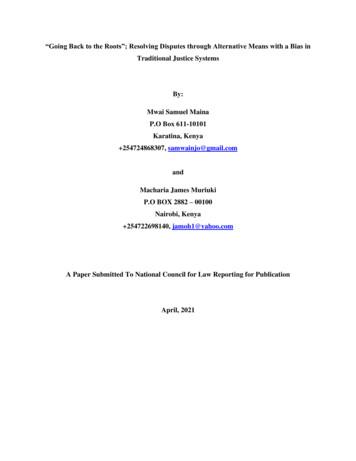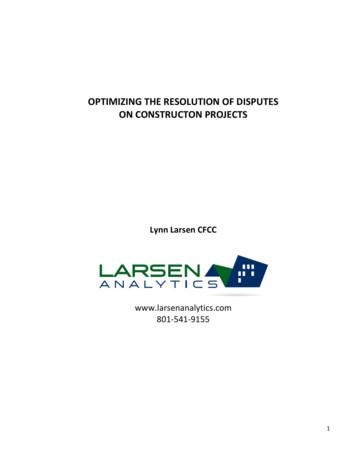Dispute Resolution Techniques And Approaches - ITU
ITU-MCMC International Training Program 2015 Dispute Resolution Techniques and Approaches Kuala Lumpur 28 August 2015 Scott Minehane (scott.minehane@windsor-place.com) Windsor Place Consulting 1
Agenda 1. Overview: Importance of effective Dispute Resolution 1. Common areas of dispute in the telecommunication sector 3. Dispute Resolution Options Formal Dispute Resolution Alternative Dispute Resolution 3. Alternative Dispute Resolution 4. Conclusions 2
Overview ICT disputes are multi-faceted and can have adverse effects on technology development, investment and consumer interests. Failure to resolve disputes quickly and effectively can; Delay the introduction of new services and infrastructure Block or reduce the flow of capital from investors Limit competition, leading to higher pricing and lower service quality Cause unnecessary expenditure in the Courts and other public services, where a dispute could be resolved effectively by other means It is important that a variety of dispute resolution procedures are available to parties so that disputes are resolved in a just, timely and cost-effective manner. 3
Common areas of dispute Common areas of dispute in the telecommunications sector relate to: Interconnection – as network deployments mature disputes relating to interconnection tend to increase in both frequency and value. Such disputes often concern technical, operational or pricing matters, or a combination. Infrastructure access – in jurisdictions where network facilities sharing is permitted, disputes between operators can arise in relation to gaining access to infrastructure and the terms on which access which may be granted. Spectrum – likely to arise where there is interference affecting one operator’s network caused by another operator and where both operators are acting in accordance with the Law. 4
Dispute Resolution: Options Dispute resolution procedures can be split into two categories. The first category is formal dispute resolution, primarily involving court adjudication. The second category is a more informal option for parties and is labeled Alternative Dispute Resolution (ADR). This category includes negotiation, mediation and arbitration. There are advantages and disadvantages to both options. 5
Formal Dispute Resolution Court adjudication is an appropriate choice for parties to a dispute when: One of the two parties to the dispute is extremely uncooperative. In order to clarify its rights, a party seeks to establish a public legal precedent rather than an award that is limited to the relationship between the parties. However, the court system in many jurisdictions often struggle to deal with complex industry disputes, with many judges lacking telecommunications-specific expertise. The use of court adjudication in complex telecommunications disputes can thus lead to high costs and delay for both parties and as well as commercially inappropriate judgments that can harm the sector. Alternative dispute resolution practices may therefore be more preferable in many commercial disputes in the telecommunications sector. 6
Alternative Dispute Resolution: Types Alternative Dispute Resolution (ADR) are procedures for settling disputes by means other than litigation or administrative adjudication. The most commonly used ADR procedures are: Negotiation A consensual process that may allow the parties to arrive at a mutually agreeable solution. The parties may be represented by legal or other counsel. Mediation A consensual process that involves a neutral third party in facilitating dispute resolution. It is generally more structured than negotiation and the discussions and process are facilitated by the mediator, however the parties still maintain control over the final outcome. 7
ADR: Types Arbitration A consensual process in which disputing parties agree to refer a dispute to a neutral third party arbitrator or panel of arbitrators for resolution. Regulatory Dispute Resolution A subset of arbitration, where regulatory authorities use their legal powers to make decisions resolving disputes brought before them. However, the range of disputes that are brought can only be relation to regulation and therefore cannot be used in private commercial disputes. 8
ADR: Advantages When used in appropriately, ADR offers several advantages for telecommunication sector disputes when compared with formal litigation procedures. These advantages include: Reduction in the time frame for resolution of disputes Cost-savings for parties to the dispute Avoidance of the unnecessary use of court resources Greater party control over the way their dispute is resolved More commercially sensitive outcomes, as parties can choose a mediator/arbitrator appropriate who has expertise in the sector 9
ADR: Advantages Guaranteed confidentiality as ADR proceedings are private, allowing parties to focus on the merit of the dispute without concern about its public impact Increased likelihood of the preservation of relationships between the parties, with ADR providing a less adversarial environment than formal litigations procedures Success in both civil and common law systems 10
ADR - Examples The promotion of a more developed market specifically aimed at telecommunications sector dispute resolution can reduce transaction costs to parties and to the sector as a whole. Examples of markets that have successfully integrated ADR into their legal systems include: Saudi Arabia and its pre-regulatory arbitration requirements Singapore and its mediation practices 11
ADR: Saudi Arabia Chapter 6 of the Saudi Telecommunications Bylaws has set forth a flexible dispute resolution mechanism in order to encourage the use of ADR. The procedures set out in the Bylaws are clear and straightforward. Primarily, a period of negotiation is required between the parties before bringing a case to the Saudi Communications and Information Technology Commission. This reduces the burden on the regulator by promoting independent settlement between the parties. Even if the parties do not reach an agreement through negotiation, such communication between the parties can narrow the issues of the dispute, reducing time and expense when the case is brought before the regulator. 12
ADR: Saudi Arabia (2) Once a case is received, the Commission is not constrained to follow an inappropriate dispute resolution procedure but has discretion to determine the best mechanism to adopt for each dispute, including mediation, final offer arbitration and regulatory adjudication. This flexible approach has the ability to take into account particular circumstances of each case in order to ensure that the most effective procedure is used. 13
ADR: Singapore The mediation movement in Singapore began in the 1990s. Since then, there has been a rapid and continuous growth in the use of mediation to resolve disputes. Private commercial mediations are conducted under the auspices of the Singapore Mediation Centre (SMC) and are governed by a standard Mediation Procedures. After a case is referred to the SMC, the SMC will match the expertise and experience of the mediators to the case to leverage on the subject matter knowledge of the mediators. 14
ADR: Singapore (2) The success of the SMC lay in its introducing private commercial mediation to the legal profession and creating a space for it in Singapore’s civil justice system. This was possible in large part due to the support of the SMC from both the Supreme Court and the Subordinate Courts, which have a system in place for referring cases to it. Additionally, SMC introduced a Mediation Charter was introduced in 2011 to further promote mediation. The Charter is a pledge that organisations undertake to signal their commitment to promote mediation through five core actions, including using mediation as a first resort to resolve the organization's disputes with other persons or organisations. 15
Questions to address Guidelines for ADR Should sector guidelines be established for mediation and arbitration procedures by the regulator? Should the telecommunications regulator require the attempt of ADR before any formal regulatory action has taken place? Should the legal system require the use of ADR before any case can be heard in court? Costs for undertaking ADR Who should forebear of the costs of ADR? Parties/regulator? Timing for ADR What time frame should be set for an ADR process before more formal dispute resolution is required? 16
Conclusion It is important that a variety of dispute resolution procedures are available to parties so that disputes are resolved in a just, timely and cost-effective manner. Due to the complex nature of many telecommunications disputes, court adjudication is sometime inappropriate and can cause unnecessary delay, expense and commercially inappropriate judgments. ADR is a more flexible approach for dispute resolution, offering many advantages that can promote positive change in the sector. With arbitration experience in Tonga and Bahrain, I have seen the positive change ADR can have to telecommunications disputes. Exemplar ADR systems can be seen in both Saudi Arabia and Singapore. 17
Useful Links Singapore Mediation System op5-sg.pdf ITU Dispute Resolution Report https://www.itu.int/ITU-D/treg/publications ITU WB Dispute Res-E.pdf 18
Thank You I am happy to answer any questions Scott W Minehane (scott.minehane@windsor-place.com) Windsor Place Consulting 61 412 995535 19
20
Dispute Resolution: Options Dispute resolution procedures can be split intotwo categories. The first category isformal dispute resolution, primarilyinvolving court adjudication. The second category is a more informal option for parties andis labeledAlternativeDispute Resolution(ADR). Thiscategory includes negotiation, mediation and arbitration.
Research Journal of English Language and Literature . 59-65. 8 Catherine Price, Alternative Dispute Resolution in Africa: Is ADR the Bridge Between Traditional and Modern Dispute Resolution?, 18 Pepperdine Dispute Resolution Law Journal pg 395 (2018) Available . 18 Pepperdine Dispute Resolution L
Pepperdine Caruso Dispute Resolution Law Journal Since 2000, the Pepperdine Caruso Dispute Resolution LawJournal (DRU) has been committed to publishing articles that explore Alternative Dispute Resolution (ADR) under various contexts.With support from the Straus Institute for Dispute Resolution
2.4 Dispute Resolution Board (DRB) 3 4 The Dispute Resolution Board (DRB) process provides an independent non-binding recommended resolution of a disagreement from skilled construction savvy individuals in "real time." Those individuals are preselected by the parties to the contract and are available to advise the resolution of a dispute at the .
The Dispute Resolution Process is set out in Section 2 of the Code. Further information along with required forms may be found in Agreed Procedure 14 of the Code. APPOINTMENT OF THE DISPUTE RESOLUTION BOARD The Disputing Parties enter into contract with the Panel Members directly rather than with the Market Operator. The Form of Dispute .
Resume Consultation * The positions of responsibility for each level of management decision-making in this resolution page are referenced in the dispute resolution ladder. ** Once the dispute resolution process reaches 1. st. level management, the time ta
Sep 20, 2012 · Richard Woods, Georgia’s School Superintendent Georgia Department of Education Educating Georgia’s Future Family Engagement, Dispute Prevention, and Dispute Resolution. Jami
the same dispute reason (whether for the same or different claims) as a single dispute under this provision for the filing of substantially similar provider payment disputes. 6.3 Disputing Requests for Overpayment Reimbursements Follow the instructions of this Section 6, Provider Dispute Resolution Process. 6.4 Other Disputes
2. Hindi 1. Amrit Hindi Pathmala – 2 (New) 2. Worksheet File 2 3. Jungle ke dost – Supplementary reader AUP AUP Manohar Puri 3. Maths 1. Grow with numbers – 2 2. Maths Worksheet File 2 (Revised) 3. Mental Maths 2 AUP AUP AUP 4. E.V.S. 1. My Vibrant Plane t – 2 AUP 5. Value Edu. 1. Grow with values 2 AUP 6. G.K. Internal Worksheets on .























